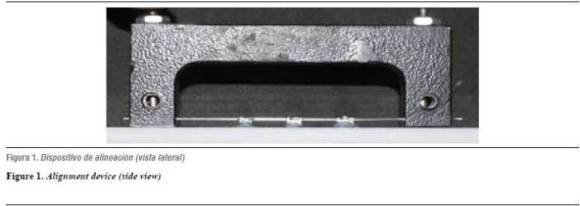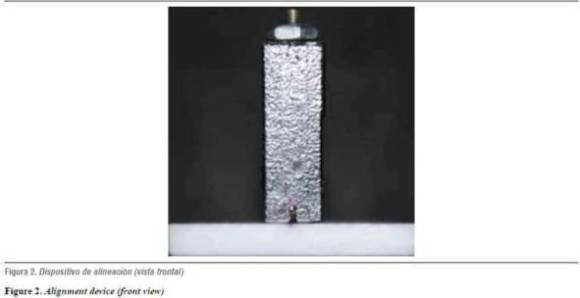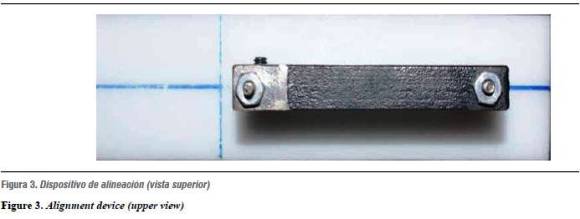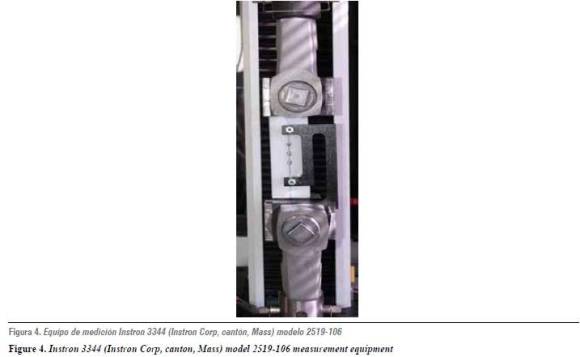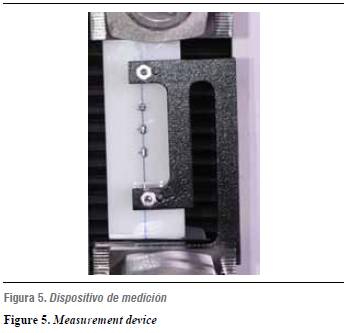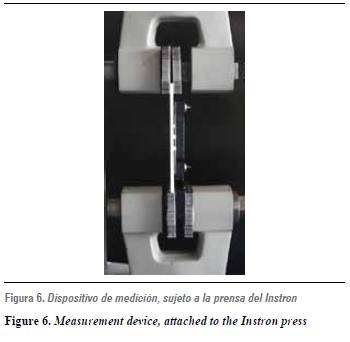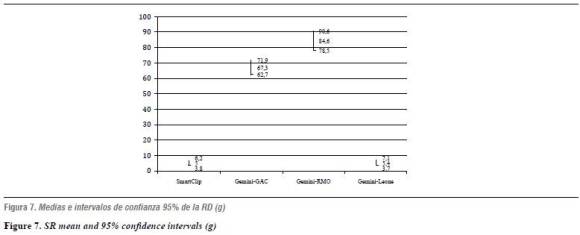Servicios Personalizados
Revista
Articulo
Indicadores
-
 Citado por SciELO
Citado por SciELO -
 Accesos
Accesos
Links relacionados
-
 Citado por Google
Citado por Google -
 Similares en
SciELO
Similares en
SciELO -
 Similares en Google
Similares en Google
Compartir
Revista Facultad de Odontología Universidad de Antioquia
versión impresa ISSN 0121-246X
Rev Fac Odontol Univ Antioq vol.23 no.2 Medellín ene./jun. 2012
ORIGINAL ARTICLES DERIVED FROM RESEARCH
Comparison of resistance to sliding produced by self-ligating Brackets and conventional brackets ligated with conventional Elastomeric ligature and low-friction ligatures
Mileny Nieto Uribe1, Judith Patricia Barrera Chaparro2, Ernesto José González Cáceres3, Ivón Lilian Parra Mazo3, Aleida Cristina Rodríguez Quijada3
1 Dentist. Orthodontist Specialist. Professor at the Orthodontics
Graduate Program, FundaciFn Universitaria San Martín
2 Dentist. Epidemiology Specialist. Research Instructor. Dentistry
Graduate School, Fundación Universitaria San Martín
3 Orthodontists. Orthodontics Graduate Program, Fundación
Universitaria San Martín
Nieto M, Barrera JP, González EJ, Parra IL, Rodríguez AC. Comparison of resistance to sliding produced by self-ligating brackets and conventional brackets ligated with conventional elastomeric ligature and low-friction ligatures. Rev Fac Odontol Univ Antioq 2012; 23(2): 192-206.
ABSTRACT
INTRODUCTION: It is important for the orthodontist to be familiar with the sliding resistance (SR) generated by the ligation method used during the space closure phase with sliding mechanics. The objective of this article is to make an in vitro comparison of the SR produced by a self-ligating bracket and a conventional bracket in combination with low-friction and conventional elastomeric ligatures.
METHODS:SmartClip (3M®) self-ligatingbrackets and Gemini (3M®) conventional brackets were used, as well as two types
of low-friction elastomeric ligature: Slide (Leone®) and Synergy (RMO®), and one type of conventional elastomeric ligature: Sani-Tie (GAC®).The brackets ligation systems were tested with stainless steel wire of 0.019 × 0.025'' caliber. Sliding resistance of the bracketwire-
ligature combination was measured with an experimental model of three brackets bonded in an acrylic plate mounted on an Instron
machine. Each combination was tested nine consecutive times in dry state.
RESULTS: The Gemini (3M®)brackets with a conventional Sani-Tie (GAC®) ligature reported mean values of 67.3 g, while the Gemini (3M®)brackets with low-friction Synergy (RMO®) silicone
ligature obtained mean values of 84.6 g. The SmartClip (3M®) and Gemini (3M®)brackets with low-friction Slide (Leone®) elastomeric ligature had similar mean values of 5.0 and 5.4 g respectively, with no significant differences (p = 0.999).
CONCLUSIONS: The Slide (Leone®) low-friction elastomeric ligatures showed sliding resistance forces similar to the SmartClip (3M®) self-ligatingbrackets.
Key words: friction, elastomeric ligature, self-ligating brackets.
INTRODUCTION
The orthodontic treatment with extractions requires a space closure phase, which may be performed in two different ways: by retracting the canines initially and then the four anterior teeth, or by means of the ''en masse'' retraction technique, which means, retracting all the six anterior teeth at the same time.1 The ''en masse'' space closure is usually made by means of sliding mechanics, consisting on sliding the archwire through the posterior brackets in order to direct the dental movement; it requires the lowest possible friction level to achieve effective space closure.2, 3 The oblique force produced between two adjacent bodies when one of them opposes the movement of the other is called friction;4 a more precise term for friction in orthodontics is sliding resistance (SR), which is defined as the opposition the bracket finds as it tries to slide through the archwire or viceversa. 5 Consequently, the force to be applied on the teeth has to be greater than the sliding resistance in order to achieve the desired orthodontic movement.6
The amount of friction produced is proportional to the strength with which the bracket and the wire must be simultaneously pressed and depends on factors such as: ligating method,6-12-14 wire composition, 11, 15, 16 wire deflection,17 archwire caliber,11, 15, 16 interbracket distance,18 bracket slot material,19 ligature lubrication, and the like..6,10,20-22
Current orthodontic practice makes extensive use of elastomeric ligatures because they facilitate the archwire-bracket union, resulting in more patient comfort; nevertheless, they produce more friction than metallic ligatures.6, 7, 23 As a consequence, new materials such as self-ligating brackets and low-friction elastomeric ligatures. 11, 24, 25 are being developed in order to reduce SR, provide the patient with more comfort, and reduce consultation and treatment time.
Self-ligating brackets have become popular as their design includes a unique clip that attaches the archwire to the bracket, or a cover that works as a fourth mobile wall that turns the slot into a tube, allowing the archwire passing over the slot with less sliding resistance;13 nevertheless, self-ligating systems have several limitations, such as the difficulty to achieve full expression of the bracket's prescription; also, its clinical handling is often more complicated than conventional supports, due to frequent clip failure, brackets are larger and more expensive, and oral hygiene becomes more difficult due to the brackets complex geometry.24 This is why during the last decade low-friction elastomeric ligatures have been introduced. Some of them act as a passive cover on the conventional bracket, allowing the free wire sliding on the slot,11 and some other are provided with a silicone addition with the intention of reducing SR,20, 21 and therefore they are very soft and highly resistant to stains, and present excellent stretching and recovery properties. Additionally, attention must be paid to the relation between the way the elastomeric ligature is positioned and the design of the bracket itself.
Few studies have assessed the SR produced by the new low-friction ligatures in comparison to self-ligating brackets. The objective of this study was to compare the SR of a type of self-ligating bracket with that of conventional brackets combined with low-friction elastomeric ligatures and conventional ligature.
METHODS
An experimental model simulating the right buccal segment in the upper arch was used to determine the SR produced by a type of self-ligating bracket and a type of conventional bracket ligated with three different mechanisms: one conventional ligature and two low-friction ligatures.
The model consisted of a rectangular acrylic plate (12 cm long x 4 cm wide x 5 mm thick), in which a bracket was bonded to the upper right second bicuspid, as well as one tube of the right upper first molar 0.022 x 0.028'' of the 3M® corporation (Unitek Monrovia California, USA), with an inter-bracket distance of 8 mm between them. They were bonded with self-curing resin (Prime-Dent VLC Orthodontic, Chicago, USA) using a device created for aligning the accessories to be evaluated, and eliminating all kind of active information that could be expressed. This device was adapted from the study by Plaza (2010),23 especially designed for this purpose. It is made of a stainless steel body and a wire segment of 0.021 x 0.025'' also made of stainless steel, parallel to the acrylic plate, which was inserted through the slots of all the bonded accessories in each plate in order to control bonding precision and to express the brackets prescription, thus allowing the archwire sliding in all the groups presenting the least possible SR at the time of measurement (figure 1 ,2 and 3)
A probabilistic sample of 9 models for each bracketwire- ligature combination was calculated, for a total of 36 models out of which: 27 corresponded to conventional Gemini (3M®), classified like this: 9 models were ligated with conventional Sani-Tie (GAC®) elastomeric ligature, 9 were ligated with low-friction Slide® (Leone Orthodontic Products) elastomeric ligature, and 9 with low friction Synergy (RMO®) silicon ligature. The 9 remaining models corresponded to self-ligating SmartClip (3M®) brackets.
The acrylic plates were marked on their backside with a code for each type of bracket/ligature combination, so that the evaluator would not know the kind of combination being assessed: A1) SmartClip (3M®) bracket; B1) Gemini (3M®) bracket ligated with elastomeric ligature (GAC®); B2) Gemini (3M®) bracket ligated with Synergy (RMO®) lowfriction silicon ligature; B3) Gemini (3M®) bracket with low-friction Slide (Leone®) elastomeric ligature. Each bracket-ligature combination was measured with a stainless steel wire of 0.019'' x 0.025'' caliber.
The SR generated by each sample model (wire, brackets, and elastomeric ligatures) was obtained by using an Instron 3344 measurement device (Instron Corp, canton, Mass), 2519-106 model, with a capacity of 2.000 N and an error margin of 0.1%, as well as the stainless steel device that was designed based on the study by Plaza (2010) 23,which was ovenpainted in order to avoid magnetization. This device was supplied with arches attached with screws in its upper and lower sections (figures 4 and 5).
This device was attached to the lower press of the Instron equipment, which is a fixed unit, and the acrylic plate was fastened to the upper press of the Instron, which is a mobile unit and slides in a vertical direction over the measurement device. A displacement of 8 mm was made for each model, with a speed of 5 mm/min (figure 6).
All the SR levels were registered as grams needed to move the archwire along the three aligned brackets; these records were transmitted to a computer. For each type of bracket-wire-elastomeric ligature combination, a series of nine SR records were taken, under dry conditions and at room temperature of 20 ± 2 °C.
After each test, the model was removed and substituted by another one with a new wire and a new ligature, provided that the bracket had been cleansed with ethanol in order to reduce errors during measurement of each bracket-wire-ligature combination.
Statistical analysis
The obtained data were recorded and refined in Excel, 2007 version; this procedure was completed in the SPSS version 15.0 software for social sciences.
The descriptive analysis used arithmetic average, minimum and maximum means, as well as standard deviation; to determine the variability level, variation coefficient was used (0-10% homogeneous, 10.1-20% moderately homogeneous, > 20% heterogeneous).
The confidence interval was determined at 95%; to determine the normality assumption the Kolgomorov-Smirnov was used, and for variance homogeneity the Levene test was applied.
To determine average friction differences, the variance analysis (ANOVA) was used, and later the Dunnet's post-Hoc test, not assuming equal variances.
The significance level was Α = 0.05, for normality and heterogeneity it was Α = 0.10.
RESULTS
After measuring sliding resistance in 36 brackets and 72 tubes divided in four groups of 9 brackets and 18 tubes: Gemini (3M®) with conventional Sani-Tie (GAC®), Gemini (3M®) low-friction Synergy (RMO®) silicone ligature, Gemini (3M®) with low-friction Slide (Leone®) elastomeric ligature and SmartClip (3M®) using a stainless steel (Dentaurum®) wire of 0.019 x 0.025'' caliber, we observed that the brackets with the greatest sliding resistance were the conventional Gemini (3M®) ligated with conventional Sani-Tie (GAC®), with an average of 67.3 g, as well as Gemini (3M®) ligated with lowfriction Synergy (RMO®) silicon ligature, with an average of 84,6 g. The SmartClip (3M®) brackets and Gemini (3M®) brackets with low-friction Slide (Leone®) elastomeric ligature showed similar average values of 5.0 and 5.4 g, respectively, as well as a greater variability coefficient. All the bracket references complied with the assumption of normality of distribution (Kolgomorov-Smirnov test)(table 1 y figura 7).
Application of the ANOVA test demonstrated that the variances were not equal in all the brackets sliding resistance combinations (Levene test, p = 0,003) (table 1). The Dunnet's post-Hoc tests were applied, and by comparing the average SR some differences were found among all bracketwire- ligature combination groups, except when comparing the SmartClip (3M®) brackets and the Gemini (3M®) brackets with low-friction Slide (Leone®) elastomeric ligature (p = 0.99) (table 2).
DISCUSSION
The purpose of this study was to compare the sliding resistance (SR) generated by self-ligating passive 3M® (SmartClip) brackets and the one produced by conventional 3M® (Gemini) brackets in combination with three types of ligature: Conventional GAC®
(Sani-Tie) elastomeric ligature, low-friction Leone® (Slide) elastomeric ligature and low-friction RMO® (Synergy) elastomeric ligature; for this purpose, a devise was specifically designed and manufactured to simulate the clinical conditions of the right posterior-upper segment of the dental arch based on a previous experimental model.23
The results of this study indicate that the SmartClip 3M® brackets and the SlideLeone® ligatures on Gemini 3M® brackets produced significantly lower friction forces in comparison with Sani-Tie GAC® and Synergy RMO® brackets on Gemini 3M® brackets, using 0.019 x 0.025'' staintess steel wires.
Similar findings are reported by previous studies, 9-11, 13, 16, 26 in which self-ligating brackets generated lower friction forces than conventional ligatures on conventional brackets. Additionally, other studies 11, 13, 14, 27 found out that Slide Leone® ligatures on conventional brackets generated SR forces significantly lower than conventional brackets on conventional ligatures because, once attached to the brackets, this type of ligature creates a passive ligature on the slot, so that the archwire is free to slide, offering the possibility of adequately controlling friction during the diverse treatment phases, just like conventional brackets on tubes 14 as reported by Baccetti.
The behavior of SR in this study shows significant differences for SmartClip 3M® brackets (5.0 g) and Slide Leone® ligatures on Gemini 3M® brackets 5.4 (5.4 g) compared to Sani-Tie GAC® ligatures on Gemini 3M® brackets (67.3 g), similar to what has been reported by Gandini et al,13 who used an experimental model of a bracket and whose results fluctuate between 0.6 g for SmartClip 3M® brackets, 0.5 g for Slide Leone® ligatures, and 153.3 g for a conventional ligature on a conventional bracket. Likewise, Plaza et al,23 also using a bracket model in dry state, reported values of 0.2 N for SmartClip 3M® brackets and 2.2 N for Sani-Tie GAC® elastomeric ligatures on Gemini 3M® brackets. In another study, Orsi et al,26 using an experimental model of a bracket in wet state, report SR values that fluctuate between 0.002 N for SmartClip 3M® brackets, 0.004 N for Slide Leone® ligatures, and 2.796 N for a conventional ligature on a conventional bracket. Although the SR reported in the present study is of a different scale, it behaves similarly to the studies presented in the literature.
Franchi et al 27 evaluated SR with a model of five brackets that replicated the right oral segment, using a nonconventional Slide Leone® elastomeric ligature on conventional brackets and four types of self-ligating brackets, finding out no significant differences between the friction produced by selfligating brackets and the ones ligated with Slide Leone® ligatures. Similarly, Gandini et al 13 reported mean values ranging from 0.1 to 1.2 g, by using a model of a SmartClip 3M® self-ligating bracket of an upper central incisor, and a conventional bracket (STEP® Leone Orthodontic Products), which were ligated with a nonconventional (Slide Leone®) elastomeric ligature and a conventional ligature (silver mini modules, Leone Orthodontic Products®) on super elastic NiTi 0,014'' and stainless steel 0.019 x 0.025'' archwires. These results agree with the ones obtained in the present study which showed that there were no SR significant differences between SmartClip 3M® brackets and conventional brackets ligated with Slide Leone® ligatures. Differences in SR values among the studies may be due to the intrinsic model used in each study. Furthermore, several authors 7, 23, 28-32 have reported metallic ligature generating lower SR in comparison to conventional elastomeric ligatures. This study omitted the use of metallic ligature as a method of archwire ligation due to the difficulty of standardizing the force produced at the moment of inserting them, although several studies have reported standardization models for using metallic ligatures.23
This study used an experimental model in dry state, just as described by other authors.6, 8, 9, 11-14, 20, 21, 23, 27, 28 Chimenti et al 21 suggest that silicon elastic modules reduce static frictional resistance in 23 to 43%, compared to non-silicon ligatures, attributing this behavior to the fact that silicon concentration in the surface remains higher in the dry state, and may be removed or softened by saliva in the wet state.
Other authors 10 state that immersion in saliva does not produce negative effect on silicon-covered ligatures. Conversely, Bortoly et al 20 did not find significant SR value differences among silicon ligatures implanted in a wet state and silicon ligatures in dry state.
When the Synergy RMO® ligature SR results obtained in this study were compared to Sani-Tie GAC® ligatures on Gemini 3M® brackets, significant differences were found, with values of 84.6 and 67.3 g respectively, in contrast to another study 21 in which lower SR values were found in silicon ligatures compared to non-silicon elastomeric ligatures due to the difference in terms of methods used for data quantification and the intrinsic conditions of each study. Conversely, Hain et al 10 reported no significant SR differences between silicon ligature and conventional elastomeric ligature, with 1.8 and 2 N respectively. Although the results of the aforementioned studies differ, they cannot be compared due to differences in terms of characteristics of the materials and methods used.
Other studies,33, 34 using Sinergy ligatures on Synergy RMO® brackets, demonstrated significantly lower SR forces, in comparison to conventional ligatures on conventional brackets. The variable behavior of the Synergy RMO® ligature in this study may be due to it being designed mainly for the Synergy RMO® system; this ligature is inserted in the two central wings out of the six wings that the Synergy® bracket has, thus making contact with a single spot of the archwire and producing less SR. When these ligatures are inserted in the fourth wings of the Gemini 3M® bracket as a conventional ligature, they make contact with two spots of the archwire, thus producing higher levels of SR. Moreover, dimensions of the elastomeric ligatures may significantly influence SR, as reported by Chimenti et al.21 In the present study, as the Synergy RMO ligature® is smaller (0.110''), in comparison to the Sani-Tie GAC® (0.120'') ligature, it may apply greater pressure on the archwire once inserted in the Gemini 3M'' bracket, thus increasing the levels of sliding resistance.
This is why commercial firms are advised to provide precise information on the applications of the new low-friction ligatures, for the dental clinician to have more control on the characteristics of the material.
The results of this study pretend to be a practical guide in the development of new criteria and tools for orthodontists to apply in their everyday practice, so that they can offer benefits in terms of effectiveness of the biomechanics commonly used in orthodontic treatments. These results must be used only for comparisons, since an in vitro study cannot precisely reproduce the friction resistance that actually occurs in vivo, where saliva, bacteria plaque accumulation, and oral cavity temperature may influence as concomitant factors in SR rate increase.
Based on the results obtained in this study, Slide Leone® ligatures on conventional Gemini 3M® brackets produce significantly lower levels of SR than Sani-Tie GAC® ligatures on conventional Gemini 3M® brackets, so it is recommended to use the Slide Leone® ligature on conventional brackets during the space closure phase with a sliding mechanics, expecting that the wire at the posterior section easily and rapidly slides through the slots of posterior brackets. As a result, this type of ligatures would become an alternative to self-ligating brackets once their effectiveness has been proved in in vivo studies.
It has been proven that low-friction Synergy RMO® elastomeric ligatures produce high levels of SR when used on conventional brackets, so it is recommended to use them exclusively with Synergy® brackets or when in need of an RS increase, thus controlling torque loss during the space closure phase with conventional brackets. Also, it would be useful to perform comparisons among the different types of ligature offered by Synergy® brackets due to their versatile design of six wings.
This study offers scientific evidence as support for future research projects, so that these findings guide the decision-making process in the clinical practice when choosing the brackets' ligature method.
CONCLUSIONS
1.SmartClip 3M® self-ligating brackets presented the expected behavior, with the lowest SR during the movement phase assessed in this study.
2. Low-friction Slide Leone® elastomeric ligatures on conventional Gemini 3M® brackets presented similar SR forces to those of SmartClip 3M® self-ligating brackets, using stainless steel wire of 0.019'' x 0.025'' caliber.
3.Low-friction Synergy RMO® ligatures used on conventional Gemini 3M® brackets present higher SR than conventional Sani-Tie GAC® on conventional Gemini 3M® brackets, using stainless steel wire of 0.019'' x 0.025'' caliber.
CORRESPONDING AUTHOR
Judith Patricia Barrera Chaparro
Carrera 18 N.° 80-94. Bogotá D. C.
Fundación Universitaria San Martín
Facultad de Posgrados de Odontología
Posgrado de Ortodoncia
Email address: barrerajudith@gmail.com
REFERENCES
1. Miles PG. Self—ligating vs. conventional twin brackets during en-masse space closure with sliding mechanics. Am J Orthod Dentofacial Orthop 2007; 132(2): 223-225. [ Links ]
2. Drescher D, Bourauel C, Schumacher HA. Frictional forces between bracket and arch wire. Am J Orthod Dentofacial Orthop 1989; 96(5): 397-404. [ Links ]
3. Kapila S, Angolkar PV, Duncanson MG Jr, Nanda RS. Evaluation of friction between edgewise stainless steel brackets and orthodontic wires of four alloys. Am J Orthod Dentofacial Orthop 1990; 98(2): 117-126. [ Links ]
4. Dowling PA, Jones WB, Lagerstrom L, Sandham JA. An investigation into the behavioural characteristics of orthodontic elastomeric modules. Br J Orthod 1998; 25(3): 197-202.
5. Thorstenson G, Kusy R. Influence of stainless steel inserts on the resistance to sliding of esthetic brackets with secondorder angulation in the dry and wet states. Angle Orthod 2003; 73(2): 167-175. [ Links ]
6. Hain M, Dhopatkar A, Rock P. The effect of ligation method on friction in sliding mechanics. Am J Orthod Dentofacial Orthop 2003; 123(4): 416-242. [ Links ]
7. Thorstenson GA, Kusy RP. Effects of ligation type and method on the resistance to sliding of novel orthodontic brackets with second-order angulation in the dry and wet states. Angle Orthod 2003; 73(4): 418-430. [ Links ]
8. Baccetti T, Franchi L, Camporesi M, Defraia E, Barbato E. Forces produced by different nonconventional bracket or ligature systems during alignment of apically displaced teeth. Angle Orthod 2009; 79(3): 533-539. [ Links ]
9. Griffiths HS, Sherriff M, Ireland AJ. Resistance to sliding with 3 types of elastomeric modules. Am J Orthod Dentofacial Orthop 2005; 127(6): 670-675. [ Links ]
10. Hain M, Dhopatkar A, Rock P. A comparison of different ligation methods on friction. Am J Orthod Dentofacial Orthop 2006;130(5): 666-670. [ Links ]
11. Tecco S, Di Iorio D, Cordasco G, Verrocchi I, Festa F. An in vitro investigation of the influence of self-ligating brackets, low-friction ligatures, and archwire on frictional resistance. Eur J Orthod 2007; 29(4): 390-397. [ Links ]
12. Camporesi M, Baccetti T, Franchi L. Forces released by esthetic preadjusted appliances with low-friction and conventional elastomeric ligatures. Am J Orthod Dentofacial Orthop 2007; 131(6): 772-725. [ Links ]
13. Gandini P, Orsi L, Bertoncini C, Massironi S, Franchi L. In vitro frictional forces generated by three different ligation methods. Angle Orthod 2008; 78(5): 917-921. [ Links ]
14. Baccetti T, Franchi L. Friction produced by types of elastomeric ligatures in treatment mechanics with the preadjusted appliance. Angle Orthod 2006; 76(2): 211-216. [ Links ]
15. Thorstenson GA, Kusy RP. Effect of archwire size and material on the resistance to sliding of self-ligating brackets with second-order angulation in the dry state. Am J Orthod Dentofacial Orthop 2002; 122(3): 295-305. [ Links ]
16. Cacciafesta V, Sfondrini MF, Ricciardi A, Scribante A, Klersy C, Auricchio F. Evaluation of friction of stainless steel and esthetic self-ligating brackets in various bracketarchwire combinations. Am J Orthod Dentofacial Orthop 2003; 124(4): 395-402. [ Links ]
17. Thorstenson GA, Kusy RP. Comparison of resistance to sliding between different self-ligating brackets with secondorder angulation in the dry and saliva states. Am J Orthod Dentofacial Orthop 2002; 121(5): 472-482. [ Links ]
18. Whitley JQ, Kusy RP. Influence of interbracket distances on the resistance to sliding of orthodontic appliances. Am J Orthod Dentofacial Orthop 2007; 132(3): 360-372. [ Links ]
19. Kusy RP, Whitley JQ. Coefficients of friction for arch wires in stainless steel and polycrystalline alumina bracket slots. I. The dry state. Am J Orthod Dentofacial Orthop 1990; 98(4): 300-312. [ Links ]
20. Bortoly TG, Guerrero AP, Rached RN, Tanaka O, Guariza- Filho O, Rosa EA. Sliding resistance with esthetic ligatures: an in-vitro study. Am J Orthod Dentofacial Orthop 2008; 133(3): 340.e1-340.e7. [ Links ]
21. Chimenti C, Franchi L, Di Giuseppe MG, Lucci M. Friction of orthodontic elastomeric ligatures with different dimensions. Angle Orthod 2005; 75(3): 421-425. [ Links ]
22. Thorstenson GA, Kusy RP. Resistance to sliding of selfligating brackets versus conventional stainless steel twin brackets with second-order angulation in the dry and wet (saliva) states. Am J Orthod Dentofacial Orthop 2001; 120(4): 361-370. [ Links ]
23. Plaza SP, Nieto M, Barrera JP, Triviño AL, Valencia A. Comparación de la resistencia al deslizamiento en brackets de autoligado y un bracket convencional. Rev Venez Ortod 2010; 27(1): 29-34. [ Links ]
24. Fortini A, Lupoli M, Cacciafesta V. A new low-friction ligation system. J Clin Orthod 2005; 39(8): 464-470. [ Links ]
25. Thomas S, Sherriff M, Birnie D. A comparative in vitro study of the frictional characteristics of two types of selfligating brackets and two types of pre-adjusted edgewise brackets tied with elastomeric ligatures. Eur J Orthod 1998; 20(5): 589-596. [ Links ]
26. Orsi L, Giuntoli F, Gandini P. Dati sperimental e conforme cliniche sulla biomecánica a bassa frizione. Bolletino di Información Leone 2008; 81: 4-7. [ Links ]
27. Franchi L, Baccetti T, Camporesi M, Barbato E. Forces released during sliding mechanics with passive self-ligating brackets or nonconventional elastomeric ligatures. Am J Orthod Dentofacial Orthop 2008; 133(1): 87-90. [ Links ]
28. Tecco S, Festa F, Caputi S, Traini T, Di Iorio D, D'Attilio M. Friction of conventional and self-ligating brackets using a 10 bracket model. Angle Orthod 2005; 75(6): 1041-1045. [ Links ]
29. Bednar JR, Gruendeman GW, Sandrik JL. A comparative study of frictional forces between orthodontic brackets and arch wires. Am J Orthod Dentofacial Orthop 1991; 100(6): 513-522. [ Links ]
30. Shivapuja PK, Berger J. A comparative study of conventional ligation and self-ligation bracket systems. Am J Orthod Dentofacial Orthop 1994; 106(5): 472-480. [ Links ]
31. Khambay B, Millett D, McHugh S. Evaluation of methods of archwire ligation on frictional resistance. Eur J Orthod 2004; 26(3): 327-332. [ Links ]
32. Taylor NG, Ison K. Frictional resistance between orthodontic brackets and archwires in the buccal segments. Angle Orthod 1996; 66(3): 215-222. [ Links ]
33. Demicheli M, Migliorati M, Balboni C, Silvestrini Biavati A. Confronto tra differenti sistemi bracket/filo/legature misurazione in vitro dell'attrito su un'intera arcata. Mondo Ortodóncico N 2006; 4: 273-280. [ Links ]
34. Franchi L, Baccetti T, Camporesi M, Giuntini V. Forces released by nonconventional bracket or ligature systems during alignment of buccally displaced teeth. Am J Orthod Dentofacial Orthop 2009; 136(3): 316-317. [ Links ]











 texto en
texto en 

